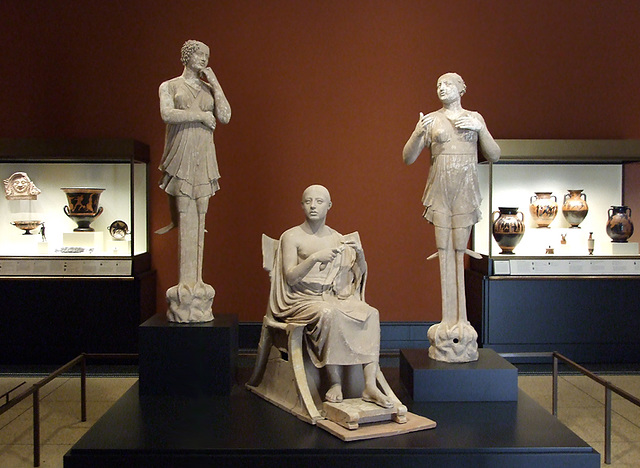Detail of a Siren in the Getty Villa, July 2008
Detail of a Poet as Orpheus in the Getty Villa, Ju…
Detail of a Siren in the Getty Villa, July 2008
Mosaic with the Removal of Briseis in the Getty Vi…
Cypriot Jug with a Man and Deer in the Getty Villa…
Sarcophagus with Scenes of Bacchus in the Getty Vi…
Sarcophagus with Scenes of Bacchus in the Getty Vi…
Sarcophagus with Scenes of Bacchus in the Getty Vi…
Detail of the Inscription on a Sarcophagus with Sc…
Detail of a Sarcophagus with Scenes of Bacchus in…
Detail of a Sarcophagus with Scenes of Bacchus in…
Detail of a Sarcophagus with Scenes of Bacchus in…
Family Forum Sign in the Getty Villa, July 2008
Reproductions of Greek Vase Shapes in the Family F…
Reproduction of an Oinochoe in the Family Forum of…
Reproduction of a Kylix in the Family Forum of the…
Reproduction of a Loutrophoros in the Family Forum…
Reproduction of a Calyx Krater in the Family Forum…
A Child Drawing on a Vase in the Family Forum of t…
Reproduction of a Panathenaic Amphora in the Famil…
Detail of a Child's Drawing of Medusa on a Reprodu…
Reproduction of a Lekythos in the Family Forum of…
Reproduction of an Amphora in the Family Forum of…
Greek Silver Kylix in the Getty Villa, July 2008
Amphora-rhyton with Satyr Heads in the Getty Villa…
Enthroned Zeus in the Getty Villa, July 2008
Enthroned Zeus in the Getty Villa, July 2008
Wounded Youth in the Getty Villa, July 2008
Funerary Lion in the Getty Villa, July 2008
Funerary Lion in the Getty Villa, July 2008
Fragment of a Kouros in the Getty Villa, July 2008
Leda and the Swan in the Getty Villa, July 2008
Leda and the Swan in the Getty Villa, July 2008
A Satyr Pouring Wine in the Getty Villa, July 2008
Pluto Sculpture in the Getty Villa, July 2008
Detail of a Panel of a Garland Sarcophagus in the…
Panel of a Garland Sarcophagus in the Getty Villa,…
Portrait of a Young Woman in the Getty Villa, July…
Portrait of a Mature Woman in the Getty Villa, Jul…
Head of Julia Titi in the Getty Villa, July 2008
Bust of a Woman in the Getty Villa, July 2008
Head of an Old Man in the Getty Villa, July 2008
Head of an Old Man in the Getty Villa, July 2008
Roman Cremation Chest in the Getty Villa, July 200…
Calyx Krater with the Death of Orpheus in the Gett…
Location
See also...
Keywords
Authorizations, license
-
Visible by: Everyone -
All rights reserved
-
1 012 visits
Orpheus and Two Sirens in the Getty Villa, July 2008


Poet as Orpheus with Two Sirens
Unknown
Greek, Tares, South Italy, about 350 - 300 B.C.
Terracotta and pigment
A seated man is flanked by sirens, creatures part bird and part woman, in this nearly life-size terracotta group. In Greek mythology, the singing of the sirens lured sailors to their deaths; thus the creatures have general funerary connotations. The seated man is also a singer, as shown by his open mouth and his now-missing lyre, which he once cradled in his left arm. His precise identity, however, is uncertain. He might be Orpheus, who was famous for his singing and who traveled to the land of the dead and was able to return. But in art of this period, Orpheus is usually shown wearing a specific Eastern costume not seen here. Therefore, this man may just be an ordinary mortal, perhaps the deceased, in the guise of a poet or singer.
Originally brightly painted, this large-scale terracotta sculpture is characteristic of the Greek colonies in South Italy. With its funerary imagery, the group may have decorated a tomb. Although terracotta sculpture is also found in mainland Greece, artists in the Greek colonies in South Italy used this medium with greater frequency and on a larger scale because there were few sources of good stone suitable for sculpting.
Text from: www.getty.edu/art/gettyguide/artObjectDetails?artobj=8398
Unknown
Greek, Tares, South Italy, about 350 - 300 B.C.
Terracotta and pigment
A seated man is flanked by sirens, creatures part bird and part woman, in this nearly life-size terracotta group. In Greek mythology, the singing of the sirens lured sailors to their deaths; thus the creatures have general funerary connotations. The seated man is also a singer, as shown by his open mouth and his now-missing lyre, which he once cradled in his left arm. His precise identity, however, is uncertain. He might be Orpheus, who was famous for his singing and who traveled to the land of the dead and was able to return. But in art of this period, Orpheus is usually shown wearing a specific Eastern costume not seen here. Therefore, this man may just be an ordinary mortal, perhaps the deceased, in the guise of a poet or singer.
Originally brightly painted, this large-scale terracotta sculpture is characteristic of the Greek colonies in South Italy. With its funerary imagery, the group may have decorated a tomb. Although terracotta sculpture is also found in mainland Greece, artists in the Greek colonies in South Italy used this medium with greater frequency and on a larger scale because there were few sources of good stone suitable for sculpting.
Text from: www.getty.edu/art/gettyguide/artObjectDetails?artobj=8398
- Keyboard shortcuts:
Jump to top
RSS feed- Latest comments - Subscribe to the comment feeds of this photo
- ipernity © 2007-2024
- Help & Contact
|
Club news
|
About ipernity
|
History |
ipernity Club & Prices |
Guide of good conduct
Donate | Group guidelines | Privacy policy | Terms of use | Statutes | In memoria -
Facebook
Twitter

Sign-in to write a comment.